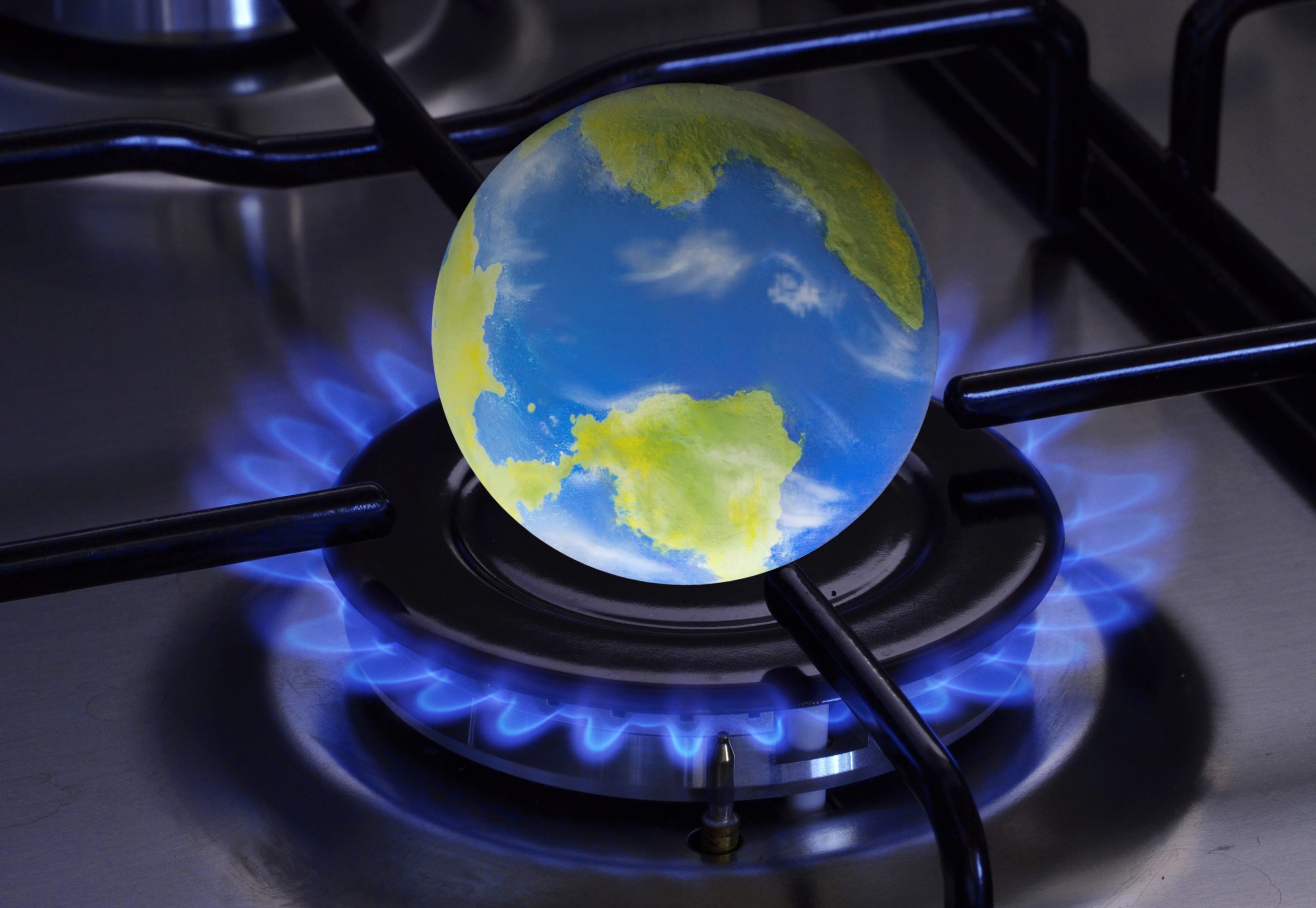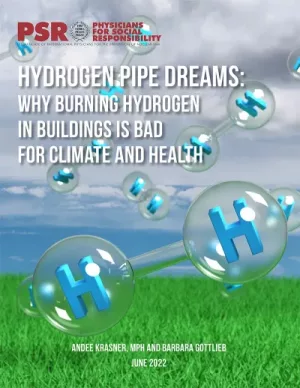Check out our infographic series at the end of this page!
Hydrogen Blending for Homes Harms
Our Climate & Health
Now, gas appliances in homes burn “natural” gas, which contains primarily methane.
Blending would instead burn a mixture of “natural” gas and hydrogen.
The fossil fuel and pipeline industries are proposing to blend hydrogen with the “natural” gas (primarily methane mixed with other gaseous hydrocarbons) that is burned in our home appliances such as heaters and stoves. In California, industry has already proposed pilot studies for blending to the state Public Utilities Commission. A partial or complete switch to hydrogen blended gas appeals to corporations because it would maintain our reliance on the current fossil fuel gas system. But hydrogen blending is not a health- or climate-friendly approach to decarbonizing our homes. Electrification is a far better option because it is already available, more efficient and cost-effective, and it provides cleaner indoor air than any gas. We at SF Bay PSR are issuing a warning against hydrogen blending for use in buildings because it poses serious climate, health, and health equity risks.
Hydrogen Blending for Homes Harms Our Climate
99% of Hydrogen is Made Using Fossil Fuels
- Ninety-nine percent of hydrogen in the U.S. is produced using fossil fuels (coal and methane). These types of hydrogen are categorized as “black,” “gray,” “blue,” or “brown” by industry, depending on how they are produced. The production of all these types of hydrogen contribute greenhouse gas emissions which destroy our climate. When methane is used to produce hydrogen, the process emits carbon dioxide, a key driver of climate change. Even if unproven methods such as carbon capture and storage (CCS) were optimally utilized to make hydrogen, it has been estimated that the lifecycle greenhouse gas impact is more than 20 percent greater than burning methane gas or coal for heat, and approximately 60 percent greater than burning diesel oil for heat, according to a recent article by Stanford and Cornell scientists in Energy Science & Engineering. Their conclusion: fossil fuel derived hydrogen “is best viewed as a distraction, something that may delay needed action to truly decarbonize the global energy economy.”
- Blending hydrogen for use in buildings would extend the use of gas-burning appliances, such as heaters and stoves, and perpetuate the toxic air pollutants that these appliances spew into our homes and atmosphere.
Less than 1% of Hydrogen is “Green”
Globally, less than one percent of available hydrogen is green, made from the electrolysis of water, rather than fossil fuels. This is an important distinction to understand because industry so often misrepresents hydrogen as a “clean” alternative to “natural” or methane gas.
Even Green Hydrogen Harms Health
- Burning hydrogen gas produces the health harming air pollutant nitrogen oxides.
- Also, our green hydrogen supplies are limited because production requires a lot of water and renewable energy. In California, and across the globe, water is a limited and precious resource.
Electrification and development of renewable energy sources (wind, solar, etc.) will end fossil fuel use more quickly and efficiently to achieve our zero-emission goals and greatly reduce health harming air pollution.


Hydrogen Blending for Homes Harms Our Health
The production and burning of blended hydrogen pose serious health risks that disproportionately affect vulnerable populations.
- The production of hydrogen increases air pollution. Exposure to air pollution damages not only our lungs but our overall health contributing to premature births, poor cognitive development, asthma, cardiovascular, respiratory, and neurological diseases. American Lung Association
- Air pollution is considered by the World Health Organization to be a top public health threat contributing to the death of about seven million people a year.
- Burning hydrogen in homes perpetuates indoor air pollution by prolonging the use of gas stoves that produce toxic air pollutants including: nitrogen dioxide, carbon monoxide, particulate matter, and benzene (a carcinogen). Gas stoves have been shown to increase air pollution in homes to levels that can exceed severe outdoor air pollution levels and can produce as much benzene as a cigarette smoker in a home.
Healthier solutions for home energy needs include electric appliances such as two-way heat pumps, induction stoves, and electric hot water heaters. These zero emissions appliances greatly reduce air pollution in our homes and are becoming more and more available and affordable, especially with the many financial incentive programs available today.
READ MORE about the health harms of gas stoves here.
American Medical Society’s (AMA) Statement Opposing Burning Hydrogen in Homes
AMA’s Reasons for Hydrogen Policy
Hydrogen Blending Increases Safety Risks: Leaky Pipes and Appliances
- Blending hydrogen for use in homes may increase the risk of accidents and fires: hydrogen leaks more easily and ignites more readily than methane at almost any air-to-fuel ratio. Local distribution pipes in large metropolitan areas leak as much as 6 percent of the gas they carry.
- The pipes that deliver “natural” gas from afar and in our homes are aging and were not made to carry hydrogen which is also more corrosive than “natural” gas. New investment to upgrade our aging and leaky “natural” gas pipe infrastructure to improve its safety is a waste of precious resources when electrification is the more efficient, cost effective, and climate friendly option.
- In short, adding hydrogen may increase the chance of gas leaks and explosions.
Hydrogen Blending for Homes Contributes to Health Inequities
- Hydrogen production and blending harm environmental justice communities by increasing air pollution in neighborhoods that are already-overburdened with pollution from industries and transportation (e.g., oil wells and refineries, shipping ports, airports, proximate freeway traffic, etc. ).
- “Natural” gas and hydrogen blends would be moved through current gas power plants and compressor stations, which are overwhelmingly situated amongst minority and/or lower-income neighborhoods. The blending of hydrogen with “natural” gas will extend both this infrastructure and the use of gas-burning appliances in lower-income homes where appliances may be old and leaky, and spaces may be smaller and/or have poor ventilation.
- Policies such as redlining have limited the neighborhoods where people of color could buy homes and reduced their ability to access credit necessary for energy efficiency retrofits. As a result, these communities are more likely than white neighborhoods to have aging appliances. Consequently, non-white, lower-income people bear the brunt of “natural” gas leaks.
- Communities of color are more likely to suffer from air pollution-related illnesses such as asthma – this is especially true of Black children, who suffer from asthma at epidemic rates.
- Lower-income households may not have health insurance or access to quality health care.
Consequently, the air pollution generated by producing and burning blended hydrogen will disproportionately harm the health of our most vulnerable communities.
Increased energy costs: The high costs of hydrogen production and delivery could result in dramatic increases in energy costs for homes with gas-burning appliances. Higher energy costs would harm lower-income households who are already having to make choices between paying for air conditioning during deadly heatwaves or buying enough food.
Finally, existing health inequities are magnified by our climate emergency. By accelerating climate change, methane and hydrogen reinforce existing health inequities.
Salem State University Study: An environmental justice analysis of distribution-level natural gas leaks in Massachusetts, USA
McGill University Study: Racial inequity in household energy efficiency and carbon emissions in the United States: An emissions paradox
What Is Happening in CALIFORNIA?
- The California Public Utilities Commission (CPUC) is considering whether to approve utility proposals for various hydrogen blending pilots. July 2024, Sierra Club: Green Groups Take Legal Action to Dismiss Hydrogen Blending Pilots—A coalition of environmental groups and consumer advocates—Sierra Club, Environmental Defense Fund, Utility Consumers’ Action Network and Climate Action Campaign—filed a motion with the California Public Utilities Commission (CPUC) to dismiss five utility pilot projects that aim to mix hydrogen into existing gas lines. The Sierra Club is represented by Earthjustice in this proceeding.
- California’s major hydrogen program is called Alliance for Renewable Clean Hydrogen Energy Systems (ARCHES). Here is an article by Sierra Club about many concerns regarding the program.
Sierra Club on ARCHES: California EJ and climate advocates urge greater transparency and community engagement in the state’s Hydrogen Hub process
CALL TO ACTION
Burning hydrogen in homes poses risks to public health and our climate. Electrification of our homes is a healthier climate solution than burning gas and hydrogen. Electric appliances are increasingly more available and affordable, especially with all the current financial subsidies.
SF Bay PSR recommends:
- Do not blend hydrogen for use in buildings.
- Support the speedy just-transition of homes to healthier electric appliances, stoves, heaters, etc.
- Engage and help protect frontline communities from air pollution and other health impacts of our climate emergency.
- Rapidly expand renewable energy production to expedite the end of fossil fuel use and decarbonization of our economy.
MORE RESOURCES
Greater Boston PSR’s hilarious explainer video: Hydrogen—Get the Facts
PSR National REPORT: important white paper on the health risks of hydrogen.
Food & Water Report: Hydrogen in Our Homes: A Dangerous Pipedream
Center for Biodiversity: Hydrogen Hurts the Climate and Frontline Communities
Food and Water Action Europe’s webinar is an excellent introduction to the public health risks inherent to developing this technology.
Washington Post: How hydrogen subsidies could cause a ‘doom loop’ for the climate
Common Wealth: Spending billions fixing gas system makes no sense: Lawmakers shouldn’t allow utilities to retool to carry new fuels
COMPLETE REFERENCE LIST HERE
INFOGRAPHICS: Hydrogen in Homes Harms Health and Climate series, click here to download
Please SHARE widely on your social media channels.
INFOGRAPHIC REFERENCE LIST HERE







